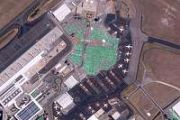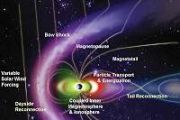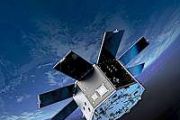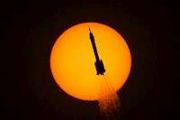
Copernical Team
Detectors could improve views of gamma-ray events
 Using technology similar to that found in smartphone cameras, NASA scientists are developing upgraded sensors to reveal more details about black hole outbursts and exploding stars - all while being less power hungry and easier to mass produce than detectors used today.
"When you think about black holes actively shredding stars, or neutron stars exploding and creating really high-energy bur
Using technology similar to that found in smartphone cameras, NASA scientists are developing upgraded sensors to reveal more details about black hole outbursts and exploding stars - all while being less power hungry and easier to mass produce than detectors used today.
"When you think about black holes actively shredding stars, or neutron stars exploding and creating really high-energy bur Galaxies go on a deep dive and leave fiery tail behind
 A group of galaxies is plunging into the Coma galaxy cluster and leaving behind an enormous tail of superheated gas. Astronomers have confirmed this is the longest known tail behind a galaxy group and used it to gain a deeper understanding of how galaxy clusters - some of the largest structures in the universe - grow to their enormous sizes.
Astronomers trained NASA's Chandra X-ray Observa
A group of galaxies is plunging into the Coma galaxy cluster and leaving behind an enormous tail of superheated gas. Astronomers have confirmed this is the longest known tail behind a galaxy group and used it to gain a deeper understanding of how galaxy clusters - some of the largest structures in the universe - grow to their enormous sizes.
Astronomers trained NASA's Chandra X-ray Observa Tianzhou 5 reconnects with Tiangong space station
 The Tianzhou 5 cargo spacecraft re-docked with the Tiangong space station early on Tuesday morning, according to the China Manned Space Agency.
In a brief news release, the agency said the robotic spaceship connected with the Tiangong station at 3:10 am.
The Tianzhou 5 launched on Nov 12 from the Wenchang Space Launch Center in Hainan province, and docked with Tiangong later that sam
The Tianzhou 5 cargo spacecraft re-docked with the Tiangong space station early on Tuesday morning, according to the China Manned Space Agency.
In a brief news release, the agency said the robotic spaceship connected with the Tiangong station at 3:10 am.
The Tianzhou 5 launched on Nov 12 from the Wenchang Space Launch Center in Hainan province, and docked with Tiangong later that sam LeoLabs accelerates radar coverage in Europe with commissioning of the Azores Space Radar
 LeoLabs, the leading commercial provider of Space Domain Awareness (SDA) services and low Earth orbit (LEO) mapping, has announced the commissioning of the LeoLabs Azores Space Radar. This radar site, located on Santa Maria Island in the Azores, Portugal adds critical coverage in Europe and supports regional and national commitments to space safety, security, and sustainability.
The Azores site
LeoLabs, the leading commercial provider of Space Domain Awareness (SDA) services and low Earth orbit (LEO) mapping, has announced the commissioning of the LeoLabs Azores Space Radar. This radar site, located on Santa Maria Island in the Azores, Portugal adds critical coverage in Europe and supports regional and national commitments to space safety, security, and sustainability.
The Azores site Sidus to launch LizzieSat with Edge AI, hyperspectral and multispectral imaging
 Sidus Space (NASDAQ: SIDU) will launch industry leading hyperspectral and multispectral imaging and Edge Artificial Intelligence (AI) in its LizzieSat satellite on SpaceX Transporter missions beginning in 2024. LizzieSat's hyperspectral and multispectral imaging capability will be provided by the Owl 1280 and Hawk 1920 HD cameras made by Raptor Photonics. Sidus is building its space-based infras
Sidus Space (NASDAQ: SIDU) will launch industry leading hyperspectral and multispectral imaging and Edge Artificial Intelligence (AI) in its LizzieSat satellite on SpaceX Transporter missions beginning in 2024. LizzieSat's hyperspectral and multispectral imaging capability will be provided by the Owl 1280 and Hawk 1920 HD cameras made by Raptor Photonics. Sidus is building its space-based infras Rwanda leaps forward in its journey to build a robust and vibrant space innovation ecosystem
 The Research Institute for Innovation and Sustainability (RIIS) and the Rwanda Space Agency (RSA) recently hosted a multi-stakeholder workshop in Rwanda in support of the space agency's drive to harness emerging space opportunities and support Rwanda's socio-economic development goals by building a vibrant and robust space innovation ecosystem.
The project to develop this ecosystem is fund
The Research Institute for Innovation and Sustainability (RIIS) and the Rwanda Space Agency (RSA) recently hosted a multi-stakeholder workshop in Rwanda in support of the space agency's drive to harness emerging space opportunities and support Rwanda's socio-economic development goals by building a vibrant and robust space innovation ecosystem.
The project to develop this ecosystem is fund What made the brightest cosmic explosion of all time so exceptional?
 Few cosmic explosions have attracted as much attention from space scientists as the one recorded on October 22 last year and aptly named the Brightest of All Time (BOAT). The event, produced by the collapse of a highly massive star and the subsequent birth of a black hole, was witnessed as an immensely bright flash of gamma rays followed by a slow-fading afterglow of light across frequencies.
Few cosmic explosions have attracted as much attention from space scientists as the one recorded on October 22 last year and aptly named the Brightest of All Time (BOAT). The event, produced by the collapse of a highly massive star and the subsequent birth of a black hole, was witnessed as an immensely bright flash of gamma rays followed by a slow-fading afterglow of light across frequencies. How activity in outer space will affect regional inequalities in the future
 Science fiction has always been a tool for processing life on Earth. Norwegian sci-fi expert Karl Kristian Swane Bambini has said that the space-bound genre is well placed to "interrogate and reimagine real-world economic disparities".
He gives the examples of, among other things, the 2013 blockbuster Elysium, wherein healthcare is only accessible off-world, to people with spaceships, and
Science fiction has always been a tool for processing life on Earth. Norwegian sci-fi expert Karl Kristian Swane Bambini has said that the space-bound genre is well placed to "interrogate and reimagine real-world economic disparities".
He gives the examples of, among other things, the 2013 blockbuster Elysium, wherein healthcare is only accessible off-world, to people with spaceships, and African space tech? Don't rule it out, says Nigeria's startup king
 Iyinoluwa Aboyeji might not have the personal wealth of Elon Musk or Mark Zuckerberg, but his level of success as an African entrepreneur bears comparison with any Silicon Valley tech titan.
While still in his twenties, the Nigerian co-founded two "unicorns", an industry term for companies that achieve a valuation of more than $1 billion.
By most counts, Africa has produced only seven un
Iyinoluwa Aboyeji might not have the personal wealth of Elon Musk or Mark Zuckerberg, but his level of success as an African entrepreneur bears comparison with any Silicon Valley tech titan.
While still in his twenties, the Nigerian co-founded two "unicorns", an industry term for companies that achieve a valuation of more than $1 billion.
By most counts, Africa has produced only seven un Cheops explores mysterious warm mini-Neptunes
 Image:
Image:
ESA’s exoplanet mission Cheops confirmed the existence of four warm exoplanets orbiting four stars in our Milky Way. These exoplanets have sizes between Earth and Neptune and orbit their stars closer than Mercury our Sun.
These so-called mini-Neptunes are unlike any planet in our Solar System and provide a ‘missing link’ between Earth-like and Neptune-like planets that is not yet understood. Mini-Neptunes are among the most common types of exoplanets known, and astronomers are starting to find more and more orbiting bright stars.
Mini-Neptunes are mysterious objects. They are smaller, cooler, and more difficult to find than the so-called hot

































